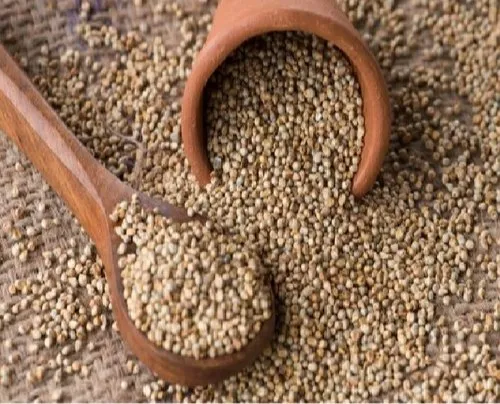Pearl Millet
Pearl millet also known as Pennisetum glaucum is a cereal crop that is widely grown in arid and semi-arid regions of the world. It is one of the most drought-resistant grains making it an important food source in regions with challenging climates. Here are some key points about pearl millet:
Characteristics
- Botanical Name: Pennisetum glaucum
- Common Names: Pearl millet Bajra (in India) Mahangu (in Namibia)
- Appearance: Pearl millet has long slender stalks that can grow up to 3 meters tall. The seeds are small round and typically light brown or gray in color.
Cultivation
- Climate: Grows well in hot and dry climates tolerating high temperatures and low rainfall.
- Soil: Prefers sandy and loamy soils but can grow in a variety of soil types including poor and infertile soils.
- Planting: Typically sown at the beginning of the rainy season. It has a short growing season usually around 70-90 days.
Nutritional Value
- High in Protein: Contains about 10-12% protein.
- Rich in Fiber: High dietary fiber content beneficial for digestive health.
- Minerals: Good source of essential minerals like iron magnesium phosphorus and zinc.
- Vitamins: Contains B-complex vitamins such as niacin folic acid thiamin and riboflavin.
Pearl millet also known as Pennisetum glaucum is a cereal crop that is widely grown in arid and semi-arid regions of the world. It is one of the most drought-resistant grains making it an important food source in regions with challenging climates. Here are some key points about pearl millet:
Characteristics
- Botanical Name: Pennisetum glaucum
- Common Names: Pearl millet Bajra (in India) Mahangu (in Namibia)
- Appearance: Pearl millet has long slender stalks that can grow up to 3 meters tall. The seeds are small round and typically light brown or gray in color.
Cultivation
- Climate: Grows well in hot and dry climates tolerating high temperatures and low rainfall.
- Soil: Prefers sandy and loamy soils but can grow in a variety of soil types including poor and infertile soils.
- Planting: Typically sown at the beginning of the rainy season. It has a short growing season usually around 70-90 days.
Nutritional Value
- High in Protein: Contains about 10-12% protein.
- Rich in Fiber: High dietary fiber content beneficial for digestive health.
- Minerals: Good source of essential minerals like iron magnesium phosphorus and zinc.
- Vitamins: Contains B-complex vitamins such as niacin folic acid thiamin and riboflavin.
Have Questions? Get In Touch!
If you have any questions about our products or services, please feel free to contact us directly or submit a request through our "call back" form.

© 2024, Venkateswara Trading . All rights reserved. Designed by Web Technoedge Solutions Pvt. Ltd.
